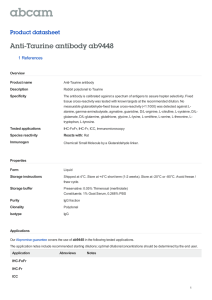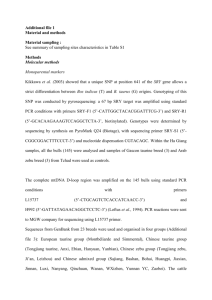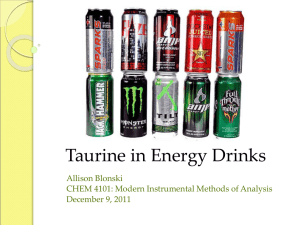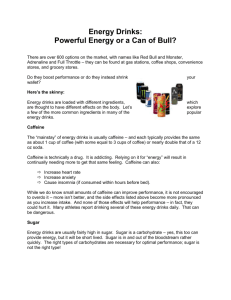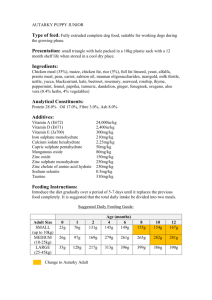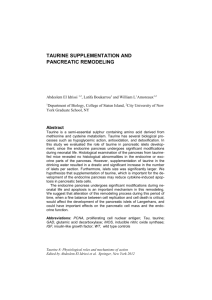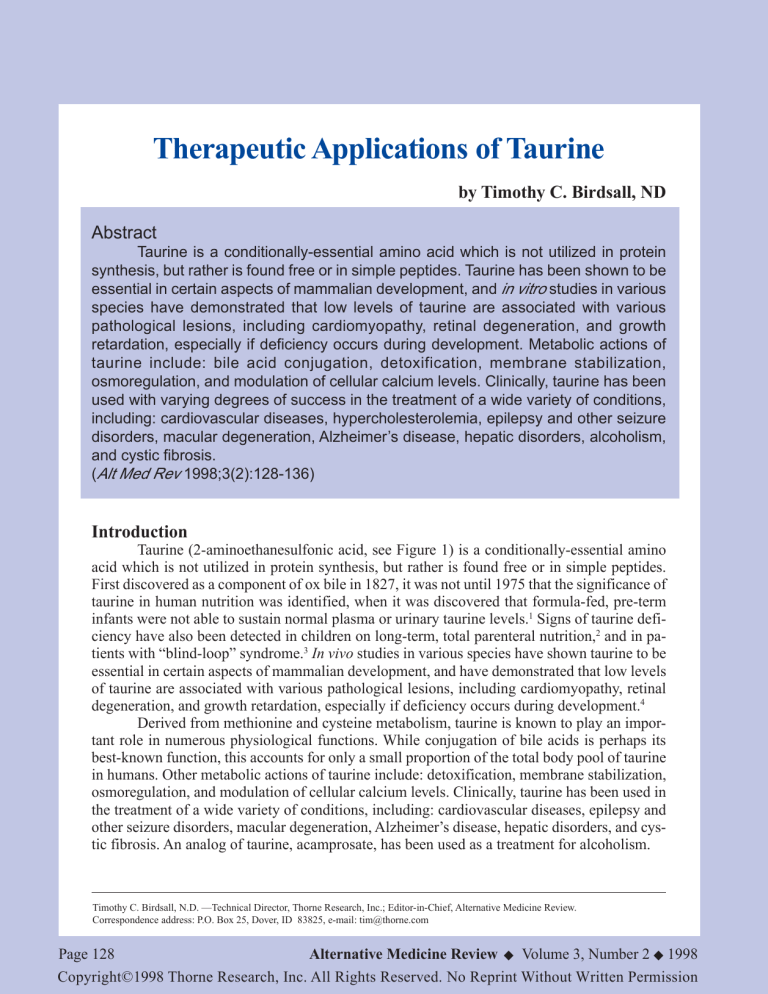
Therapeutic Applications of Taurine
by Timothy C. Birdsall, ND
Abstract
Taurine is a conditionally-essential amino acid which is not utilized in protein
synthesis, but rather is found free or in simple peptides. Taurine has been shown to be
essential in certain aspects of mammalian development, and in vitro studies in various
species have demonstrated that low levels of taurine are associated with various
pathological lesions, including cardiomyopathy, retinal degeneration, and growth
retardation, especially if deficiency occurs during development. Metabolic actions of
taurine include: bile acid conjugation, detoxification, membrane stabilization,
osmoregulation, and modulation of cellular calcium levels. Clinically, taurine has been
used with varying degrees of success in the treatment of a wide variety of conditions,
including: cardiovascular diseases, hypercholesterolemia, epilepsy and other seizure
disorders, macular degeneration, Alzheimer’s disease, hepatic disorders, alcoholism,
and cystic fibrosis.
(Alt Med Rev 1998;3(2):128-136)
Introduction
Taurine (2-aminoethanesulfonic acid, see Figure 1) is a conditionally-essential amino
acid which is not utilized in protein synthesis, but rather is found free or in simple peptides.
First discovered as a component of ox bile in 1827, it was not until 1975 that the significance of
taurine in human nutrition was identified, when it was discovered that formula-fed, pre-term
infants were not able to sustain normal plasma or urinary taurine levels.1 Signs of taurine deficiency have also been detected in children on long-term, total parenteral nutrition,2 and in patients with “blind-loop” syndrome.3 In vivo studies in various species have shown taurine to be
essential in certain aspects of mammalian development, and have demonstrated that low levels
of taurine are associated with various pathological lesions, including cardiomyopathy, retinal
degeneration, and growth retardation, especially if deficiency occurs during development.4
Derived from methionine and cysteine metabolism, taurine is known to play an important role in numerous physiological functions. While conjugation of bile acids is perhaps its
best-known function, this accounts for only a small proportion of the total body pool of taurine
in humans. Other metabolic actions of taurine include: detoxification, membrane stabilization,
osmoregulation, and modulation of cellular calcium levels. Clinically, taurine has been used in
the treatment of a wide variety of conditions, including: cardiovascular diseases, epilepsy and
other seizure disorders, macular degeneration, Alzheimer’s disease, hepatic disorders, and cystic fibrosis. An analog of taurine, acamprosate, has been used as a treatment for alcoholism.
Timothy C. Birdsall, N.D. —Technical Director, Thorne Research, Inc.; Editor-in-Chief, Alternative Medicine Review.
Correspondence address: P.O. Box 25, Dover, ID 83825, e-mail: tim@thorne.com
Page 128
Alternative Medicine Review ◆ Volume 3, Number 2 ◆ 1998
Copyright©1998 Thorne Research, Inc. All Rights Reserved. No Reprint Without Written Permission
Alternative Medicine Review ◆ Volume 3, Number 2 ◆ 1998
Page 129
Copyright©1998 Thorne Research, Inc. All Rights Reserved. No Reprint Without Written Permission
Taurine
effects of taurine are probably due to its ability to protect the heart from the adverse efAlthough frequently referred to as an
fects of either excessive or inadequate calcium
amino acid, it should be noted that the taurine
ion (Ca2+) levels.13 The consequence of Ca2+
molecule contains a sulfonic acid group, rather
excess is the accumulation of intracellular calthan the carboxylic acid moiety found in other
cium, ultimately leading to cellular death. Tauamino acids. Unlike true amino acids, taurine
rine may both directly and indirectly help reguis not incorporated into proteins, and is one of
late intracellular Ca2+ ion levels by modulatthe most abundant free amino acids in many
ing the activity of the voltage-dependent Ca2+
tissues, including skeletal and cardiac muscle,
channels, and by regulation of Na+ channels.
and the brain.5
Taurine also acts on many other ion channels
In the body, taurine is synthesized from
and transporters. Therefore, its action can be
the essential amino acid methionine and its requite non-specific. 14 When an adequate
lated non-essential amino acid cysteine (see
amount of taurine is present, calcium-induced
Figure 2). There are three known pathways for
myocardial damage is significantly reduced,
the synthesis of taurine from cysteine. All three
perhaps by interaction between taurine and
pathways require pyridoxal-5'-phosphate
membrane proteins.15 At least one study has
(P5P), the active coenzyme form of vitamin
suggested taurine’s ability to
B6, as a cofactor. A vitamin
function as a membrane staB6 deficiency has been shown
bilizer is related to its capacto impair taurine synthesis.6
Figure 1. Structure of Taurine
ity to prevent suppression of
The activity of cysmembrane-bound NaK ATteine sulfinic acid decarboxyO
H
16
Pase.
lase (CSAD), the enzyme
Other research demonwhich converts both cysteine
CH2
HO
S
C
strates taurine can protect the
sulfinic acid into hypotaurine,
heart
from neutrophil-induced
and cysteic acid into taurine,
reperfusion
injury and oxidaO
H
NH2
is thought to reflect the capactive stress. Because the respiity for taurine synthesis. 7
ratory burst activity of neutroCompared to other mammals,
phils is also significantly reduced in the preshumans have relatively low CSAD activity,
ence of taurine, perhaps taurine’s protective
and therefore possibly lower capacity for tau8
effect is mediated by its antioxidative properrine synthesis. Much of the published research
ties.17
on taurine has involved studies done on cats,
Azuma and associates have observed
which do not synthesize taurine, but must con5
that
taurine
alleviates physical signs and sympsume it in their diet. Therefore, since humans
toms of congestive heart failure (CHF).18-20
have the capacity to synthesize at least some
Chazov et al were able to demonstrate that tautaurine, it is unclear to what extent feline studrine could reverse EKG abnormalities such as
ies can be extrapolated to humans.
S-T segment changes, T-wave inversions, and
extra systoles in animals with chemically-inCardiovascular Effects
duced arrhythmias.21
Taurine comprises over 50 percent of
A double-blind, placebo-controlled
the total free amino acid pool of the heart.9 It
crossover study suggested, “taurine is an
has a positive inotropic action on cardiac tiseffective agent for the treatment of heart failure
sue,10 and has been shown in some studies to
without any adverse effects.” 22 Fourteen
lower blood pressure.11,12 In part, the cardiac
Biochemistry and Metabolism
Figure 2. Synthesis of Taurine
METHIONINE
Mg
B12, folate, betaine
homocysteine
P5P
cystathionine
P5P
CYSTEINE
cysteine
sulfinic acid
P5P
P5P
cysteamine
hypotaurine
TAURINE
CONJUGATED
BILE ACIDS
P5P
P5P
P5P
cysteic acid
isethionic acid
β - sulfinyl - pyruvate
P5P - Pyridoxal 5' Phosphate
pyruvate
patients (9 men and 5 women) with CHF were
evaluated initially and baseline data were
obtained. Patients were assigned a “heartfailure score” based on the degree of dyspnea,
pulmonary sounds, signs of right-heart failure,
and chest film abnormalities. All patients were
continued on digitalis with diuretics and/or
vasodilators throughout the study period.
Patients received 6 grams per day in divided
doses of either taurine or placebo for four
weeks, followed by a 2-week “wash-out”
period. Prior to the cross-over period, baseline
data were obtained for the following study
period, in which patients received placebo or
taurine, whichever was not taken during the
first study period. Heart-failure scores fell from
5.8 ± 0.7 before taurine administration to 3.7
± 0.5 after taurine (p < 0.001); the score did
not change significantly during the placebo
period. A “favorable response was observed
in 79 percent (11/14 patients) during the
taurine-treated period and in 21 percent (3/14
patients) during the placebo-treated period; 4
patients worsened during the placebo period,
whereas none did during the taurine period (p
less than 0.05).”22
Research has also been conducted in
animals to determine whether oral taurine
increased survivability in CHF which resulted
from surgically-induced aortic regurgitation.
Albino rabbits received either taurine (100 mg/
kg) or placebo after surgical damage to the
aortic cusps, which produced aortic
regurgitation. “Cumulative mortality at 8
Page 130
Alternative Medicine Review ◆ Volume 3, Number 2 ◆ 1998
Copyright©1998 Thorne Research, Inc. All Rights Reserved. No Reprint Without Written Permission
Bile Acid Conjugation and
Cholesterol Excretion
The liver forms a 2-4 gram bile acid
pool that has approximately ten enterohepatic
cycles per day, with the terminal ileum serving as the main absorption site for the
enterohepatic recycling of approximately 80
percent of these acids. Bile acids function as a
detergent for emulsification and absorption of
lipids and fat-soluble vitamins. Critical to this
function of bile are the bile salts which, because of their lipophilic and hydrophilic components, can lower surface tension and form
micelles. Two major bile acids are derived
from hepatic cholesterol metabolism: cholic
acid and chenodeoxycholic acid. From these
primary bile acids, intestinal bacteria form the
secondary bile acids deoxycholic acid and lithocholic acid, respectively. For these bile acids to be solubilized at physiological pH, it is
essential they be conjugated through peptide
linkages with either glycine or taurine; these
amino acid conjugates are referred to as bile
salts.
Taurine conjugation of bile acids has
a significant effect on the solubility of cholesterol, increasing its excretion, and administration of taurine has been shown to reduce serum cholesterol levels in human subjects. In a
single-blind, placebo-controlled study, 22
healthy male volunteers, aged 18-29 years,
were randomly placed in one of two groups
and fed a high fat/high cholesterol diet, designed to raise serum cholesterol levels, for
three weeks. The experimental group received
6 grams of taurine daily. At the end of the test
period, the control group had significantly
higher total cholesterol and LDL-cholesterol
levels than the group receiving taurine.24
Cystic Fibrosis
Most cystic fibrosis (CF) patients suffer from nutrient malabsorption, where much
of the insult is in the ileum. Since the terminal
ileum serves as the main absorption site for
the enterohepatic recycling of approximately
80 percent of bile acids, they are malabsorbed
as well. Taurine supplementation has been
shown to decrease the severity of steatorrhea
associated with many CF cases.25,26 In one
double-blind crossover study, 13 CF children
with steatorrhea of at least 13 grams per day
were treated with a taurine dose of 30 mg/kg/
day. The study continued for two consecutive
4-month durations and involved both placebo
and treatment periods. Ninety-two percent of
the CF children showed decreased fecal fatty
acid and sterol excretion while taking taurine.25
In CF patients with a high degree of steatorrhea, bile acid absorption was increased with
taurine supplementation, suggesting a possible
role for taurine in treating malabsorption.26
Detoxification
Due to its ability to neutralize hypochlorous acid, a potent oxidizing substance,
taurine is able to attenuate DNA damage
caused by aromatic amine compounds in
vitro.27 Because of taurine’s unique structure,
containing a sulfonic acid moiety rather than
carboxylic acid, it does not form an aldehyde
from hypochlorous acid, forming instead a
relatively stable chloroamine compound.
Hence, taurine is an antioxidant that specifically mediates the chloride ion and hypochlorous acid concentration, and protects the body
from potentially toxic effects of aldehyde release.
Taurine has also been reported to
protect against carbon tetrachloride-induced
toxicity. 28-31 In rats exposed to carbon
Alternative Medicine Review ◆ Volume 3, Number 2 ◆ 1998
Page 131
Copyright©1998 Thorne Research, Inc. All Rights Reserved. No Reprint Without Written Permission
Taurine
weeks of non-treated rabbits following aortic
regurgitation was 52% (12/23 animals)
compared with 11% (1/9 animals) in taurinetreated group (p less than 0.05)... Taurine
prevented the rapid progress of congestive
heart failure induced artificially by aortic
regurgitation, and consequently prolonged the
life expectancy.” 23
tetrachloride (CCl4), hepatic taurine content
decreased significantly 12 and 24 hours after
CCl 4 administration. However, oral
administration of taurine to CCl4-exposed rats
was able to protect these animals from hepatic
taurine depletion, suggesting that hepatic
taurine may play a critical role in the protection
of hepatocytes against hepatotoxins such as
CCl4.28
Exposure to bacterial endotoxins has
been suggested as one factor which can augment the magnitude of individual responses
to xenobiotics.32 Circulating endotoxins of intestinal origin have been found to create a positive feedback on endotoxin translocation from
the gut, stimulating increases in serum endotoxin levels. In experimental animals, taurine
was found to significantly inhibit intestinal
translocation and to protect the animals from
endotoxemic injury.33 Therefore, it is possible
taurine might be able to modify factors underlying susceptibility to toxic chemicals.
Hepatic Disorders
Two groups of patients with acute
hepatitis, all with serum bilirubin levels above
3 mg/dl, were studied in a double-blind, randomized protocol. Subjects in the treatment
group received 4 grams of taurine three times
daily. Bilirubin, total bile acids, and biliary
glycine:taurine ratio all decreased significantly
in the taurine group within one week as compared to controls.34
Alcoholism
Twenty-two patients undergoing
treatment for alcohol withdrawal were given
1 gram of taurine three times per day orally
for seven days. When compared to
retrospective controls, significantly fewer of
the taurine-treated patients had psychotic
episodes (14% vs. 45%, p < 0.05). The number
of psychotic cases after admission who had
also been psychotic before admission was
1/16 for the taurine group and 11/17 for the
controls (p < 0.001).35
Recently, acamprosate, a synthetic taurine analog, has been shown to be clinically
useful in the treatment of alcohol dependence.36-41 Currently available only in Europe,
acamprosate (calcium acetylhomotaurinate)
has a chemical structure similar to that of
gamma-aminobutyric acid, and is thought to
act via several mechanisms affecting multiple
neurotransmitter systems, and by modulation
of calcium ion fluxes. About 50 percent of alcoholic patients relapse within three months
of treatment. In a pooled analysis of data from
11 randomized, placebo-controlled trials involving a total of 3,338 patients with alcohol
dependence, those treated with acamprosate
showed higher abstinence rates and durations
of abstinence during 6- to 12-month post-treatment follow-up periods, when compared to
those receiving placebo.36
In a two-year, randomized, doubleblind, placebo-controlled study, 272 patients
initially were given short-term detoxification
treatment, and then received routine counseling and either acamprosate or placebo for 48
weeks, after which they were followed for
another 48 weeks without medication. Subjects
who received acamprosate showed a significantly higher continuous abstinence rate at the
end of the treatment period compared to those
who were assigned to the placebo group (43%
vs 21%, p = .005), and they had a significantly
longer mean abstinence duration of 224 vs 163
days, or 62 percent vs 45 percent days abstinent (p < .001). However, there was no difference in psychiatric symptoms. At the end of a
further 48 weeks without receiving study
medication, 39 percent and 17 percent of the
acamprosate- and placebo-treated patients, respectively, had remained abstinent (p = .003).37
Two in vitro studies have been
published comparing the effects of
acamprosate and calcium acetyltaurinate on
ionic membrane transfer.40,41 Ethanol has been
Page 132
Alternative Medicine Review ◆ Volume 3, Number 2 ◆ 1998
Copyright©1998 Thorne Research, Inc. All Rights Reserved. No Reprint Without Written Permission
Ocular Disorders
The retina contains one of the highest
concentrations of taurine in the body. In cats,
when the retina has been depleted to about onehalf its normal taurine content, changes in the
photoreceptor cells begin to appear, and further depletion can result in permanent retinal
degeneration.42 In some respects, the retinal
degeneration seen in the human disease retinitis pigmentosa (RP) is similar to that observed
in taurine-deficient cats. However, studies of
plasma and platelet taurine levels in patients
with RP have yielded very inconsistent results.43-45 A clinical trial of taurine (1-2 g/day)
for one year in patients with RP did not result
in any laboratory or clinical evidence of improvement, although some subjective benefits
were reported.46
Epilepsy
Although several clinical trials
involving taurine supplementation in epileptic
patients have been reported, most have major
methodological flaws.47 Depending on the
criteria used, the degree of success reported
in various trials using taurine in the treatment
of epilepsy has been between 16 and 90
percent.48-56 In these trials, dosages ranged
from 375 to 8,000 mg/day. The precise role of
taurine in synaptic transmission is uncertain,
and its antiepileptic action, confirmed in
several models of experimental epilepsy and
in short-term clinical studies, does not seem
to possess major clinical relevance since trials
with a longer follow-up period have generally
produced less satisfactory results. Taurine’s
limited diffusibility across the blood-brain
barrier may be the main factor restricting the
antiepileptic effect of this compound.
Alzheimer’s Disease
Levels of the neurotransmitter acetylcholine have been described as abnormally low
in patients with Alzheimer’s disease. These insufficient levels are presumed to be related to
the memory loss which characterizes the condition, and treatment of Alzheimer’s disease
based on this premise has been proposed.57
Taurine administered to experimental animals
has been able to increase the level of acetylcholine in the brain,58 and researchers have
demonstrated that decreased concentrations of
taurine are present in the cerebral spinal fluid
of patients with advanced symptoms of
Alzheimer’s disease when compared to agematched controls.59 To date, no clinical trials
on the use of taurine for the treatment of
Alzheimer’s disease have been reported in the
medical literature.
Diabetes
Both plasma and platelet taurine levels have been found to be depressed in insulin-dependent diabetic patients; however, these
levels were raised to normal with oral taurine
supplementation. In addition, the amount of
arachidonic acid needed to induce platelet aggregation was lower in these patients than in
healthy subjects. Taurine supplementation reversed this effect as well, reducing platelet aggregation. In vitro experiments demonstrated
that taurine reduced platelet aggregation in diabetic patients in a dose-dependent manner,
while having no effect on the aggregation of
platelets from healthy subjects.
Conclusion
Although it is readily apparent that taurine is important in conjugating bile acids to
Alternative Medicine Review ◆ Volume 3, Number 2 ◆ 1998
Page 133
Copyright©1998 Thorne Research, Inc. All Rights Reserved. No Reprint Without Written Permission
Taurine
shown to reduce ionic transfer through
alterations in the cationic paracellular pathway,
the coupling between two adjacent epithelial
cells, the monovalent cation pump, and the
antiport system. In both of these studies, the
results indicate two closely related compounds
have different effects on ionic membrane
transfer. Therefore, caution should be used in
extrapolating the effects of acamprosate to
taurine or other taurine analogs.
form water-soluble bile salts, only a fraction
of available taurine is used for this function.
Taurine is also involved in a number of other
crucially important processes, including calcium ion flux, membrane stabilization, and
detoxification. Some areas of investigation into
the clinical uses of taurine have revealed significant applications for this amino acid: congestive heart failure, cystic fibrosis, toxic exposure, and hepatic disorders. Other conditions
such as epilepsy and diabetes will require further research before a clear rationale for the
use of taurine can be developed.
References
1.
2.
3.
4.
5.
6.
7.
8.
9.
10.
Raiha N, Rassin D, Heinonen K, Gaull GE.
Milk protein quality and quantity: Biochemical
and growth effects in low birth weight infants
(LBWI). Pediatr Res 1975;9:370.
Geggel HS, Ament ME, Heckenlively JR, et al.
Nutritional requirement for taurine in patients
receiving long-term parenteral nutrition. N
Engl J Med 1985;312:142-146.
Sheik K, Toskes P, Dawson W. Taurine
deficiency and retinal defects associated with
small intestinal bacterial overgrowth. Gastroenterology 1981;80:1363.
Sturman JA. Taurine in development. Physiol
Rev 1993;73:119-147.
Huxtable RJ. Physiological actions of taurine.
Physiol Rev 1992;72:101-163.
Shin HK, Linkswiler HM. Tryptophan and
methionine metabolism of adult females as
affected by vitamin B6 deficiency. J Nutr
1974;104:1348-1355.
Hayes KC. Taurine requirement in primates.
Nutr Rev 1985;43:65-70.
Worden JA, Stipanuk MH. A comparison by
species, age and sex of cysteinesulfinate
decarboxylase activity and taurine concentration in liver and brain of animals. Comp
Biochem Physiol 1985;82:233-239.
Jacobsen JG, Smith LH. Biochemistry and
physiology of taurine and taurine derivatives.
Physiol Rev 1968;48:424-511.
Huxtable RJ and Sebring LA. Cardiovascular
actions of taurine. In: Kuriyama K, Huxtable
R, Iwata H (eds.), Sulfur Amino Acids:
Biochemical and Clinical Aspects. New
York:Alan R. Liss;1983:5-37.
11.
12.
13.
14.
15.
16.
17.
18.
19.
20.
21.
22.
23.
Nara Y, Yamori Y, Lovenberg W. Effects of
dietary taurine on blood pressures in spontaneously hypertensive rats. Biochem Pharmacol
1978;27:2689-2692.
Bousquet P, Feldman J, Bloch R, Schwartz J.
Central cardiovascular effects of taurine:
comparison with homotaurine and muscimol. J
Pharmacol Exp Ther 1981;219:213-218.
Satoh H. Cardioprotective actions of taurine
against intracellular and extracellular Ca2+induced effects. Adv Exp Med Biol
1994;359:181-196.
Satoh H, Sperelakis N. Review of some
actions of taurine on ion channels of cardiac
muscle cells and others. Gen Pharmac
1998;30:451-463.
Kramer JH, Chovan JP, Schaffer SW. Effect of
taurine in calcium paradox and ischemic heart
failure. Am J Physiol 1981;240:H238-H246.
Qi B, Yamagami T, Naruse Y, et al. Effects of
taurine on depletion of erythrocyte membrane
Na-K ATPase activity due to ozone exposure
or cholesterol enrichment. J Nutr Sci Vitaminol
1995;41:627-634.
Raschke P, Massoudy P, Becker BF. Taurine
protects the heart from neutrophil-induced
reperfusion injury. Free Radic Biol Med
1995;19:461-471.
Azuma J, Hasegawa H, Sawamura A, et al.
Therapy of congestive heart failure with orally
administered taurine. Clin Ther 1983;5:398408.
Azuma J, Sawamura A, Awata N, et al.
Therapeutic effect of taurine in congestive
heart failure: a double-blind crossover trial.
Clin Cardiol 1985;8:276-282.
Azuma J, Sawamura A, Awata K. Usefulness
of taurine in chronic congestive heart failure
and its prospective application. Jpn Circ J
1992;56:95-99.
Chazov EI, Malchikova LS, Lipina NV, et al.
Taurine and electrical activity of the heart.
Circ Res 1974;35 (Suppl 3):11-21.
Azuma J, Takihara K, Awata N, et al. Taurine
and failing heart: experimental and clinical
aspects. Prog Clin Biol Res 1985;179:195-213.
Azuma J, Takihara K, Awata N, et al. Beneficial effect of taurine on congestive heart
failure induced by chronic aortic regurgitation
in rabbits. Res Commun Chem Path Pharm
1984;45:261-270.
Page 134
Alternative Medicine Review ◆ Volume 3, Number 2 ◆ 1998
Copyright©1998 Thorne Research, Inc. All Rights Reserved. No Reprint Without Written Permission
25.
26.
27.
28.
29.
30.
31.
32.
33.
34.
35.
36.
Mizushima S, Nara Y, Sawamura M, Yamori Y.
Effects of oral taurine supplementation on
lipids and sympathetic nerve tone. Adv Exp
Med Biol 1996;403:615-622.
Smith U, Lacaille F, Lepage G, et al. Taurine
decreases fecal fatty acid and sterol excretion
in cystic fibrosis. A randomized double-blind
study. Am J Dis Child 1991;145:1401-1404.
Carrasco S, Codoceo R, Prieto G, et al. Effect
of taurine supplements on growth, fat absorption and bile acid on cystic fibrosis. Acta Univ
Carol 1990;36:152-156.
Kozumbo WJ, Agarwal S, Koren HS. Breakage and binding of DNA by reaction products
of hypochlorous acid with aniline, l-naphthylamine or l-naphthol. Toxicol Appl Pharmacol
1992;115:107-115.
Nakashima T, Taniko T, Kuriyama K. Therapeutic effect of taurine administration on
carbon tetrachloride-induced hepatic injury.
Jpn J Pharmacol 1982;32:583-589.
Waterfield CJ, Turton JA, Scales MD, Timbrell
JA. Reduction of liver taurine in rats by betaalanine treatment increases carbon tetrachloride toxicity. Toxicology 1993;77:7-20.
Timbrell JA, Waterfield CJ. Changes in taurine
as an indicator of hepatic dysfunction and
biochemical perturbations. Studies in vivo and
in vitro. Adv Exp Med Biol 1996;403:125-134.
Wu C, Miyagawa C, Kennedy DO, et al.
Involvement of polyamines in the protection of
taurine against the cytotoxicity of hydrazine or
carbon tetrachloride in isolated rat hepatocytes.
Chem Biol Interact 1997;103:213-224.
Roth RA, Harkema JR, Pestka JP, Ganey PE.
Is exposure to bacterial endotoxin a determinant of susceptibility to intoxication from
xenobiotic agents? Toxicol Appl Pharmacol
1997;147:300-311.
Wang WY. Intestinal endotoxin translocation
in endotoxemic rats. Sheng Li Ko Hsueh Chin
Chan 1995;26:41-44.
Matsuyama Y, Morita T, Higuchi M, Tsujii T.
The effect of taurine administration on patients
with acute hepatitis. Prog Clin Biol Res
1983;125:461-468.
Ikeda H. Effects of taurine on alcohol withdrawal. Lancet 1977;2(8036):509.
Wilde MI, Wagstaff AJ. Acamprosate. A
review of its pharmacology and clinical
potential in the management of alcohol
dependence after detoxification. Drugs
1997;53:1038-1053.
37.
38.
39.
40.
41.
42.
43.
44.
45.
46.
47.
48.
Sass H, Soyka M, Mann K, Zieglgansberger
W. Relapse prevention by acamprosate.
Results from a placebo-controlled study on
alcohol dependence. Arch Gen Psychiatry
1996;53:673-680.
Whitworth AB, Fischer F, Lesch OM, et al.
Comparison of acamprosate and placebo in
long-term treatment of alcohol dependence.
Lancet 1996;347:1438-1442.
Paille FM, Guelfi JD, Perkins AC, et al.
Double-blind randomized multicentre trial of
acamprosate in maintaining abstinence from
alcohol. Alcohol Alcohol 1995;30:239-247.
Bara M, Guiet-Bara A, Durlach J, Pechery C.
Comparative studies of Ca Nacetylhomotaurinate and Ca N-acetyltaurinate.
I. Effects on the ionic transfer through the
isolated human amnion. Methods Find Exp
Clin Pharmacol 1995;17:233-240.
Guiet-Bara A, Bara M, Durlach J, Pechery C.
Comparative studies of Ca Nacetylhomotaurinate and Ca N-acetyltaurinate.
II. Preventive and opposing actions of the
acute ethanol depletive effect on the ionic
transfer through the isolated human amnion.
Methods Find Exp Clin Pharmacol
1995;17:361-368.
Sturman JA. Nutritional taurine and central
nervous system development. Ann NY Acad Sci
1986;477:196-213.
Airaksinen EM, Oja SS, Marnela KM, Sihvola
P. Taurine and other amino acids of platelets
and plasma in retinitis pigmentosa. Ann Clin
Res 1980;12:52-54.
Uma SM, Satapathy M, Sitaramayya A.
Decreased plasma taurine levels in retinitis
pigmentosa. Biochem Med 1983;30:49-52.
Voaden MJ, Hussain AA, Chan IRP. Studies on
retinitis pigmentosa in man. I. Taurine and
blood platelets. Br J Ophthalmol 1982;66:771775.
Reccia R, Pignalosa B, Grasso A, Campanella
G. Taurine treatment in retinitis pigmentosa.
Acta Neurologica 1980;18:132-136.
Fariello RG, Golden GT, McNeal RB Jr.
Taurine and related amino acids in seizure
disorders - current controversies. Prog Clin
Biol Res 1985;179:413-424.
Airaksinen EM, Oja SS, Marnela KM, et al.
Effects of taurine treatment on epileptic
patients. Prog Clin Biol Res 1980;39:157-166.
Alternative Medicine Review ◆ Volume 3, Number 2 ◆ 1998
Page 135
Copyright©1998 Thorne Research, Inc. All Rights Reserved. No Reprint Without Written Permission
Taurine
24.
49.
50.
51.
52.
53.
54.
55.
56.
57.
58.
59.
60.
Barbeau A, Inoue N, Tsukada Y, Butterworth
RF. The neuropharmacology of taurine. Life
Sci 1975;17:669-678.
Bergamini L, Mutani R, Delsedime M, Durelli
L. First clinical experience on the antiepileptic
action of taurine. Eur Neurol 1974;11:261-269.
Konig P, Kriechbaum G, Presslich O, et al.
Orally-administered taurine in therapyresistant epilepsy. Wien Klin Wochenschr
1977;89:111-113.
Marchesi GF, Quattrini A, Scarpino O,
Dellantonio R. Therapeutic effects of taurine in
epilepsy: a clinical and polyphysiographic
study. Riv Patol Nerv Ment 1975;96:166-184.
Mongiovi A. Clinical study on the control of
epilepsy using taurine. Riv Neurol
1978;48:305-325.
Takahashi R, Nakane Y. Clinical trial of
taurine in epilepsy. In: Barbeau A, Huxtable
RJ, eds. Taurine and Neurological Disorders.
New York:Raven Press;1978:375.
Van Gelder NM, Sherwin AL, Sacks C,
Anderman F. Biochemical observations
following administration of taurine to patients
with epilepsy. Brain Res 1975;94:297-306.
Mantovani J, DeVivo DC. Effects of taurine on
seizures and growth hormone release in
epileptic patients. Arch Neurol 1979;36:672674.
Alder JT, Chessell IP, Bowen DM. A neurochemical approach for studying response to
acetylcholine in Alzheimer’s disease.
Neurochem Res 1995;20:769-771.
Tomaszewski A, Kleinrok A, Zackiewicz A, et
al. Effect of various amino acids on acetylcholine metabolism in brain tissue. Ann Univ
Mariae Curie Sklodowska 1982;37:61-70.
Csernansky JG, Bardgett ME, Sheline YI, et al.
CSF excitatory amino acids and severity of
illness in Alzheimer’s disease. Neurology
1996;46:1715-1720.
Franconi F, Bennardini F, Mattana A, et al.
Plasma and platelet taurine are reduced in
subjects with insulin-dependent diabetes
mellitus: effects of taurine supplementation.
Am J Clin Nutr 1995;61:1115-1119.
Page 136
Alternative Medicine Review ◆ Volume 3, Number 2 ◆ 1998
Copyright©1998 Thorne Research, Inc. All Rights Reserved. No Reprint Without Written Permission

